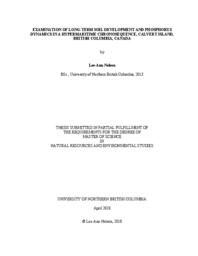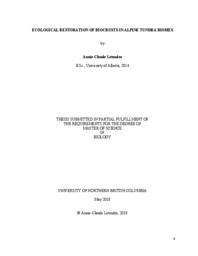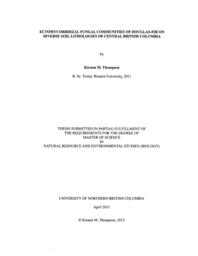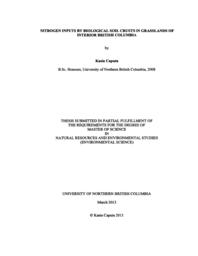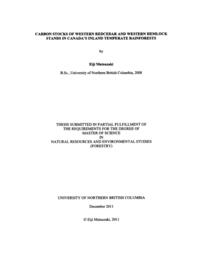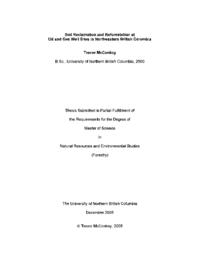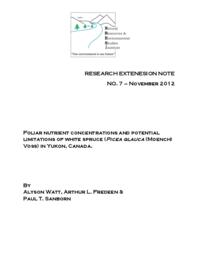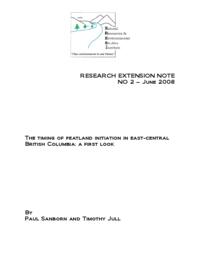Sanborn, Paul T.
Person Preferred Name
Paul T. Sanborn
Related Works
Content type
Digital Document
Description / Synopsis
The aim of this dissertation is to investigate and quantify biophysical diversity on landslides in the boreal forest of the Peace River Region of northern British Columbia (BC), sampling three landslides that occurred in the last 50 years. Landslides are increasing in the boreal forest, likely driven by climate changes such as increased precipitation and permafrost thaw, and as a derivative of large wildfires. An understanding of ecosystem recovery on landslides is important for conservation and management purposes. Several studies have been done in southern parts of the world to elucidate processes of landslide recovery. However, few studies have addressed landslide recovery in northern climates, and little is known about the biophysical diversity of landslides in this region. This research investigates whether landslides are more biophysically diverse than the surrounding relatively undisturbed terrain, and whether microsite variables or geomorphic diversity are predictors of plant community diversity. Using a series of field sampling campaigns and GIS (geographic information system) mapping exercises, I show that landslides are more biophysically diverse than the surrounding terrain in some respects, while the surrounding undisturbed terrain is more diverse in other aspects. The age and size of landslides also appear to influence diversity. Microsite diversity does not necessarily predict plant diversity. The research highlights the role of invasive plant species in slope stabilisation and plant community makeup. I also show that landslide ponds are disproportionately concentrated on rotational landslides, and that most ponds on landslides occur in the body and toe. I note post-slide modifications such as drainage of landslide ponds and lowering of landslide ridges, but many geomorphic features are expected to endure for decades to millennia. Overall, the research shows that vegetation recovery is complex and may take decades to fully manifest. This study contributes knowledge about plant community and site diversity on landslides by providing quantitative data and comparing those traits with those found on surrounding terrain. These findings can be used as guidance when identifying conservation and management practices for ecological restoration of disturbed slopes.
Origin Information
Content type
Digital Document
Description / Synopsis
It is prudent to understand how tree growth responds to climate variability to better project their growth in the current and future changes in climate in boreal forests. In this thesis, I studied how climate variables influence individual white spruce trees (Picea glauca (Moench) Voss) over short and intermediate periods in pure and mixedwood stands in northeastern British Columbia. In Chapter 2, I studied the importance and the influence of annual, seasonal, and monthly microclimate variables on the annual growth of white spruce trees in pure and mixedwood stands. In Chapter 3, I studied the importance and the influence of microclimate variables on sap flow of white spruce trees through different time scales in these two stand types. My key finding in these two chapters is that stand composition and structure are essential determinants of how spruce radial growth and sap flow respond to fluctuations in climate variables, and how they will respond to projected future climate scenarios. A combination of warmer temperatures and drought during summer will negatively affect white spruce trees growth in pure and mixedwood stands in the studied region. Spruce sap flow in both stand types is likely to increase as the climate warms, increasing the demand for soil water. As this resource becomes less available, white spruce in both stand types are likely to respond with processes that can compromise their physiological integrity. White spruce growing in mixedwood stands might be more sensitive to drought stress than in pure stands due to the higher competition for limiting resources (primarily water). This thesis provides information of expected changes in tree growth to climate variability and demonstrates the importance of appropriate site selection to plant spruce trees and management of pure and mixedwood stands.
Origin Information
Content type
Digital Document
Description / Synopsis
Plant communities and soils of grasslands on an elevation gradient and the forest-grassland mosaic in the Cariboo-Chilcotin of British Columbia were examined. Vegetation change along an elevation-climate gradient was analysed, including plant cover, litter cover, species composition, and species richness. Grassland plant communities were compared with associated climate variables and biogeoclimatic classifications. Based on results, an updated classification of grassland ecosystems is proposed with suggestions for management and research. Plant community and soil moisture characteristics of adjacent forests and grasslands were compared. Ten-year-old slash and burn treatments of young forests, and areas of forest encroachment on grasslands were studied to detect potential change between forest and grassland states. Results did not suggest change in ecosystem state between grasslands and forests, with persistent ecosystem legacies a potential source of long-term resilience. Land-use legacies manifested as encroachment of forests on areas of historical grasslands and high cover values of exotic species.
Origin Information
Content type
Digital Document
Description / Synopsis
I studied how microclimate variables influence the growth of white spruce trees (Picea glauca (Moench) Voss) in pure and mixedwood stands in north-eastern British Columbia. My key finding is that stand composition and structure are essential determinants of how spruce radial growth and sap flow respond to fluctuations in climate variables. A combination of warmer temperatures and drought during summer will negatively affect white spruce trees growth in pure and mixedwood stands in the studied region. Spruce sap flow in both stand types is likely to increase as the climate warms, increasing the demand for soil water. White spruce growing in mixedwood stands might be more sensitive to drought stress than in pure stands due to the higher competition for limiting resources (primarily water). I provide information that will be useful in modeling and managing these stands across western Canada under current and future climate conditions.
Origin Information
Content type
Digital Document
Description / Synopsis
Carbon (C) storage in residual live lodgepole pine trees in northern BC at Kennedy Siding was measured 11 and 12 years after a severe mountain pine beetle (MPB) epidemic. Kennedy Siding eddy covariance (EC) measurements showed that the net ecosystem productivity (NEP) was quick to recover C sink status. In this study, measurements of heights and diameters of 160 residual live lodgepole pine trees and a subset of 60 tree cores were used to calculate residual tree stem C-storage in 2017 and 2018 (36.01 and 26.71 g C m-2 yr-1 respectively). Dendrochronology analyses indicated that residual pine trees released on average 392% in the decade following versus the decade prior to MPB-attack. Stem C-storage was strongly and positively correlated with ECNEP measurements (R2=0.77) and percent downed canopy trees (R2=0.837), suggesting that growth release of residual trees was likely driven by improvements in resources (e.g. light, moisture, nutrient).
Origin Information
Content type
Digital Document
Origin Information
Content type
Digital Document
Origin Information
Content type
Digital Document
Origin Information
Content type
Digital Document
Origin Information
Content type
Digital Document
Origin Information
Content type
Digital Document
Origin Information
Content type
Digital Document
Origin Information
Content type
Digital Document
Origin Information
Content type
Digital Document
Description / Synopsis
"Although nutrient deficiencies are not uncommon in forests across the north, little is known about these limitations in the Yukon, and even less about how these limitations have been and/or will be affected by climate. To address existing edaphic limitations to forests in the Yukon, an investigation of the nutrient concentrations of white spruce (Picea glauca (Moench) Voss) foliage was undertaken throughout various regions of Yukon in 2009. By comparing individual nutrient concentrations to critical values and reviewing nutrient ratios, the results identified nitrogen (N) as being commonly severely deficient. Phosphorus (P) and sulphur (S) were also commonly deficient, whereas magnesium (Mg) and potassium (K) were mostly adequate with few reports of slight deficiency levels. In contrast, calcium (Ca) was adequate at all locations. Of the micronutrients, zinc (Zn) and manganese (Mn) were the only elements in adequate supply at all sites while slight to moderate deficiencies were commonly indicated for all other micronutrients across the study area. Nutrient limitations may ultimately restrict the growth response of white spruce to climate changes and/or increasing atmospheric CO₂."
Origin Information
Content type
Digital Document
Description / Synopsis
"A pilot study at the Aleza Lake Research Forest (ALRF) in east-central interior British Columbia (BC) examined the timing of peatland initiation using accelerator radiocarbon dating of peat deposits. At the ALRF, Sphagnum bogs occupy numerous closed depressions in an undulating plain underlain by impervious, fine-textured glacial lake sediments. Four adjacent Sphagnum bogs differed greatly in depth, with maximum peat thicknesses ranging from 70 to >550 cm. The oldest peat (9,177 ± 55 ¹⁴C yr BP) occurred in a deposit less than 2 m thick, while a basal peat sample could not be obtained from the deepest basin examined. Two bogs with thinner deposits yielded younger basal peat ages (<4000 ¹⁴C yr BP). More recent peatland initiation in shallower depressions may have been triggered by moister regional climates after the mid-Holocene. Future studies of peatland carbon stocks and peatland history in central BC will need to consider this potential climate sensitivity and the spatial variability in peat thickness. Plant macrofossils and charcoal preserved in peat deposits could provide additional evidence for Holocene paleoenvironments in this region."
Origin Information






